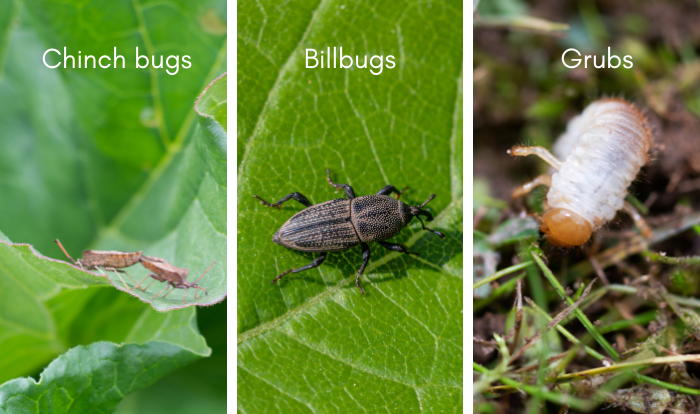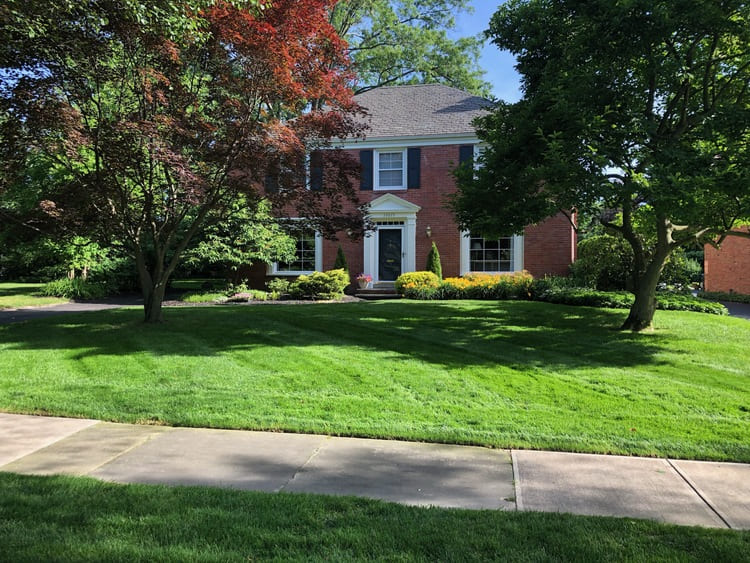Home » Lawn Pests »
Lawn Drought Stress or Pests? Know the Signs!

Summer’s officially here! While we dream of grilling and soaking up the sun on lush lawns, scorching temperatures can also bring hidden threats.
Here’s how to tell if your lawn is suffering from drought stress or sneaky insect damage and what to do about it.
Signs of Drought Stress in Lawns
Even well-maintained lawns sometimes fall victim to drought stress, especially during hot summer months. The key to reviving your lawn is recognizing the signs of thirst, which can sometimes mimic pest damage. Here’s what to watch out for:
- Color Changes: Watch for a shift from your lawn’s usual vibrant green to a dull grayish-blue or light purple tint. In severe drought, the blades may turn light brown and become brittle, resembling straw.
- Slow Recovery: Take a walk on your lawn and pay attention to how it responds. If your footprints or mower tire tracks linger instead of the blades bouncing back quickly, it’s a sign of drought stress.
- Cracked Soil: Cracked or gapping soil, especially near paved areas, is a clear indication that your lawn needs a generous watering.
How to Manage Drought Stress in Lawns
Luckily, when trying to rid your lawn of drought stress, returning to the basics of lawn maintenance is usually the recipe for a healthier lawn. Here’s what we recommend:
- Monitor Watering: Ensure your lawn receives about 1.5 inches of water per week, applied early in the morning every other day.
- Proper Mowing Height: Set your mower to the tallest setting, measure the distance from the bottom of the mower blade to the pavement, and ensure it’s the proper cutting height. Edging vertically ensures your lawn edges are the same height as the rest of the lawn.
- Regular Lawn Maintenance: Keep your lawn slightly taller to shade the soil, prevent weeds, and reduce reliance on weed control products. Taller grass also reduces moisture evaporation, saving on water bills.
Have you tried treating your lawn for drought, but it is still struggling? It might be pests!

Common Lawn Pests and How to Spot Them
Addressing drought stress is crucial, but sometimes, your lawn might not bounce back even with proper watering. This could be a sign of pests lurking beneath the surface. To help you diagnose the problem, we’ll explore three common lawn pests found in Ohio and how to identify them.
1. Chinch Bugs
Chinch bugs are small lawn pests that can cause significant damage at various stages of their lifecycle. The nymphs, or baby chinch bugs, are initially orange-red and gradually turn black as they mature. Adults are about ⅙ inch long, with black bodies and distinct areas. Their white wings lay flat on their backs, forming a recognizable X-shape pattern.
These pests harm lawns by sucking sap from grass blades with their piercing-sucking mouthparts. During feeding, they extract plant sap and inject a toxin, causing the grass to wilt, turn yellow, brown, and eventually die.
Chinch bugs are most active from late June to early September, thriving in hot, dry, sunny areas of the lawn.
Lawn Damage They Cause: If you suspect chinch bugs are causing your lawn issues, look for yellow or brown patches in sunny areas, especially during hot, dry weather.
How to Test for Chinch Bugs: Check the edges of dead grass patches, where chinch bugs tend to move outward as the grass dies. You can also perform the “tin can test” or “float test”: push a metal cylinder (such as a coffee can) three inches into the soil, fill it ¾ with water, and leave it for 10 minutes. Gently agitate the turf under the water; if Chinch Bugs are present, they will float to the top. Count the number of bugs you see; 15 or more per square foot indicates a moderate infestation that requires treatment.
2. Billbugs
Billbugs are ¼ to ½ inch-long beetles with hard wing covers and a distinctive, beak-like snout. They have clubbed antennae ranging from black to dull red and brown, with some species displaying distinctive markings. The larvae are cream-colored with reddish-brown head capsules, legless, and can grow up to ½ inch long.
Adult Billbugs damage grass blades by chewing holes to deposit their eggs. The larvae feed inside the grass stems and later drop into the soil to feed on roots and crowns. These pests are most active in late spring and early summer.
Lawn Damage They Cause: The larvae, or the infant stage of this insect, cause the most severe damage by feeding on stems, roots, and crowns. The affected grass turns brown, yellow, or tan and appears dead. This grass then becomes easily pulled up with no roots attached. The damage often appears as irregular patches that spread outward and can be mistaken for drought stress or other irrigation-related problems.
How to Test for Bill Bugs: Look for Billbugs by observing brown, dead patches in the lawn that don’t respond to watering. You can perform the “tug test”: pull on the affected grass areas, and if it comes up easily without roots, Billbugs may be present. They also leave sawdust-like frass (excrement) at the base of grass plants. You might also see bill bugs on paved areas on warm spring days where the adults are likely to be found.
3. Grubs
You’ve probably heard of them if you haven’t seen a grub! Grubs are the larval stage of various beetle species, such as Japanese Beetles, which cause defoliation on perennials and shrubs in the landscape. Grubs are white or cream-colored with brown heads, have a C-shaped body, and can range from ½ inch to 2 inches long, depending on the species and stage.
These pests cause damage by living underground in the soil. They feed on grass roots and organic matter and become most active in late summer and early fall. They overwinter in the soil and resume feeding in the spring.
Lawn Damage They Cause: Grubs eat grass roots, causing the turf to die in large patches. Over time, this weakens the grass roots, making the grass feel spongy and easy to pull up. Brown patches may appear on the lawn, especially in late summer or early fall. Additionally, grubs can attract wildlife to your lawn such as skunks, raccoons, or moles, which dig for grubs. However, be cautious, as moles don’t always indicate a grub problem.
How to Test for Grubs: Perform the “tug test”: pull on grass in affected areas, and if it comes up easily without roots, grubs may be present. Check for “sponginess” when walking on the lawn or look for signs of animal damage, such as torn-up turf from animals foraging for grubs. Finding about five or more grubs per square foot indicates a potential problem, and ten or more grubs per square foot usually require treatment.
Treatment for Pests
So, you’ve spotted chinch bugs or billbugs in your lawn and want them gone for good. But hold on before you hit the home improvement store! Those bottled solutions often require treating a large area yourself, which can be a hot, sweaty hassle. Imagine spending hours walking back and forth across your lawn, hoping you applied it correctly. Even worse, if there are any mistakes, you’d have to start all over again.
1. Chinch Bugs & Billbugs
At Ecolawn, we believe defense is the best offense when it comes to lawn care. That’s why all our plans automatically include surface insect control in early and late summer applications. This targets chinch bugs and billbugs when they’re young and most vulnerable.
2. Grubs
Effective treatment is all in the timing of the applications with grubs, as you should target them in their larvae stage development. In Ohio, grub preventers should be applied in summer from June to August, when grubs hatch into young larvae. Our Guaranteed Grub Protector (included in every plan) ensures that the grubs don’t develop into the more destructive stages.
Remember, prevention is key!
To give your lawn the best chance of survival, it’s crucial to support its health by fertilizing, providing it with organic nutrients, and removing invasive weeds throughout the year. This approach strengthens your lawn from the roots up, making it naturally more resistant to pests, diseases, and even harsh weather.
Contact Ecolawn For Your Lawn Care Needs in Mentor, Ohio
If you’re noticing signs that your lawn is struggling with drought or potential pests, we’re here to help! Contact us for a complimentary consultation so we can provide the solutions you need to maintain your beautiful and healthy Ohio lawn.
Join Our Newsletter
FOLLOW US FOR MORE LAWN CARE TIPS

